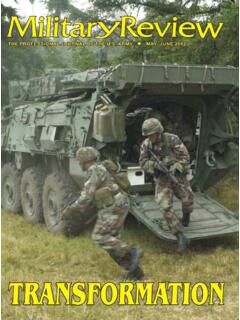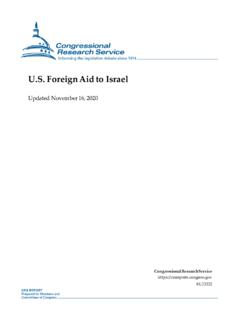Transcription of Toward Combined Arms Warfare:-
1 Toward Combined Arms Warfare:- A Survey of 20th~Century Tactics, Doctrine, and Organization by Captain Jonathan M. House, Army August 1984 Army Command and General Staff College Fort Leavenworth, KS 660274900 Library of Congress Gataloging in Publication Data House, Jonathan M. (Jonathan Mallory), l&X?- Toward Combined arms warfare. (Research survey / Combat Studies Institute; no. 2) August k984. Bibliography: p. 1. Tactics--History--20th century. 2. Armies-- Organization--History--20th century. 3. Military art and science--History--20th century. I. Title. II. Series: Research survey ( Army Command and General Staff College. Combat Studies Institute; no. 2) 1985 2 85-W For sale by the Superintendent of Documents, Gavemaent Printting OWce, WeshEngton, 28402 CONTENTS iii iv V Introduction .. 1 Chapter One. Prologue to 1914 .. 7 Chapter Two. World War I.. 19 Chapter Three.
2 43 Chapter Four. World War II: The Axis Advance, 1939-1942.. 79 Chapter Five. World War II: The Complexity of Total War, 1942-1945.. 105 Chapter Six. Combined Arms After 1945 .. e .. 141 Conclusion .. 181 Notes .. 191 Bibliography .. 207 iii FIGURES 1 Type French and German Divisions, 1914.. e . 10 2. Type British and Russian Divisions, 1914. a . e . e * . = 11 3. Trench System, World War I.. * . l . , .. a e .. 23 4. Type and German Divisions, 1918.. e .. a . 41 5. Type German Panzer Division, 1935 .. a (F . c m .. * * . 56 6. French Light Mechanized Division, 1934, and Armored Division,.1940 e a s .. a . e e .. = t s 62 7. Soviet Mechanized Carps, December 1935, and MotorizedDivision, *..* *.*..$.. 67 8. , Triangular Infantry Division, June 1941. + .. e . 74 9. British Armored and Infantry Divisions, 1942.. * .. t . 90 10. Schematic of Blitzkrieg Encirclement.)
3 M .. = .. 98 11. Soviet Tank Corps5 1942, and Tank Army, 1943. * .. 101 12. Type Armored Division, March 1942 and September 1943.. f .. c .. e e * .. 109 13. Soviet Assault Group Formation. V .. * .. 124 14. Type Soviet Tank Division, 1947, and Mechanized Division, 1946/51. e .. 143 15. Type Infantry and Armored Divisions, 1947.. l . 148 16. Pentamic Infantry Division . e m .. l .. * e .. 156 17. Type Armored Division, ROAD, 1965-1983 . e m .. 159 18. 1st Cavalry Division (Airmobile), 1965.. * . e 163 iv MAPS 1. Battle of Cambrai, 20-30 November 1917.. 30 2. Second Battle of Armageddon, 19-24 September 1918 .. 38 3. The Maginot Line and the 1940 Campaign.. 59 4. Khalkin-Gol, lo-31 August 1939.. 70 5. Sidi Barrani, December 1940 .. 92 6. Sidi Bou Zid - Kasserine Pass, February 1943.. 120 7. Imphal-Kohima, March-April 1944 .. 136 8. Task Force Dolvin, Anyang-ni, Korea, 5 February 1951.
4 151 9. Lam Son 719, February-March 1971.. 166 10. 7th Armored Brigade at Abu Agheila, 1956.. 175 V - INTRODUCTION We have gotten into the fashion of talking of cavalry tactics, artillery tactics, and infantry tactics. This distinction is nothing but a mere abstraction. There is but one art, and that is the tactics of the Combined arms. The tactics of a body of mounted troops composed of the three arms is subject to the same established principles as is that of a mixed force in which foot soldiers bulk largely. The only difference is one of mobility. -Major Gerald Gilbert, British Army, 1907 l The concept of llCombined Arms has existed for centuries, but the nature of the combination and the organizational level at which it occurred have varied greatly. Prior to the seventeenth century, for example I there was often no need to combine infantry, artillery, and cavalry at the small-unit level.
5 Each branch served a specific function on the battlefield, and only the senior commanders present needed to coordinate the effects of the different arms. In succeeding centuries, the general trend has been to combine the arms at progressively lower levels of organization. The concern of commanders has gone from coordinating the separate actions of separate arms, to gaining greater cooperation between them, and finally to combining their actions to maximize the effect of their various properties. At the time that Gilbert made his plea, many officers paid lip service to Combined arms, but few understood the need to achieve such cooperation or combination between the branches at the small-unit level. Since then, twentieth century warfare and especially mechanized warfare have developed to the point at which some form of Combined arms is essential for survival, let alone victory, on the battlefield.
6 Yet the very complexity of this warfare leads to specialization in both training and maintenance, a specialization that is currently reflected in the formation of companies and battalions consisting of one or at most three different major weapons sys terns. A mechanized infantry battalion, for example, normally includes direct-fire infantry weapons, antitank weapons, and limited indirect-fire support in the form of mortars and grenade launchers. Such a battalion has little or no organic capability in the areas of armor, air defense, engineers, long-range indirect fire, or air support. A tank or artillery battalion is even more specialized and restricted in its equipment. 1 Although these units are task organized and cross attached for field operations, the demands of specialization, unit identity, and maintenance naturally cause many soldiers to concentrate on the use of one weapon or arm to defeat the corresponding weapon or arm of the enemy.
7 Such a narrow view has frequently characterized professional soldiers, who wish naturally to conserve techniques that seem effective. This simplistic approach is perhaps less common among senior commanders and within infantry or reconnaissance (armored cavalry) units, where the different weapons are integrated on a more frequent basis than in some other organizations. Still, at least some tank crews train primarily to fight enemy tanks, tactical fighter units seek air superiority over enemy fighters, and engineers concentrate on enhancing the mobility of their own forces while impeding the mobility and eountermooility efforts of enemy engineers. All of these tasks are essential for combat success, but none by itself will ensure proper interaction between the different arms and weapons. Indeed, almost by definition a particular arm or weapon system has most of the same strengths and weaknesses of its enemy counterpart, and thus may not provide the best means of defeating that enemy.
8 The very term " Combined arms" often means different things to different people, or is left undefined and vague. As a minimum, however, this term includes at least three related elements: 1 The Combined arms concept is the basic idea that different arms and weapons systems must be used in concert to maximize the survival and combat effectiveness of each other. The strengths of one system must be used to compensate for the weaknesses of others. Exactly which arms and weapons are included in this concept varies greatly between armies and over time. Today, however, the list of Combined arms would include at least the following: infantry (mechanized, motorized, airborne, air assault, light, and special or unconventional operations forces1, armor, cavalry/reconnaissance, artillery, antitank forces, air defense, combat engineers, attack helicopters, and some form of close air support. Under certain circumstances, this list may also include electronic warfare and, when authorized, nuclear and chemical fires.)
9 Beyond this basic list, all the combat support and serviee support elements are equally important if the force is to fight in a coordinated and sustained manner. In the interests of brevity, however, logistical aspects of Combined arms will be discussed only briefly in this study. 2. Combined arms organization, at whatever level (company, battalion, brigade/regiment, etc.), brings these 2 differe:lt arms and weapons systems together for combat. This may include both fixed, peacetime tables of organization and ad hoc or task-organized combinations of elements in wartime. 3. Combined arms tactics and operations are the actual roles performed and techniques applied by these different arms and weapons in supporting each other once they have been organized into integrated teams. This is the area that is of most concern to professional soldiers, yet it is precisely this area where historical records and tactical manuals often neglect important details.
10 Moreover, Combined arms tat tics and techniques at the level of battalion or below are the most difficult aspects about which to generalize historically, because they are most subject to frequent changes in technology. A short study such as this cannot possibly consider all the complexities that these three elements bring to recent military history. Hhat it can do is trace some recurring themes or problems in the recent conduct of Combined arms warfare in the British, French, German, Soviet, and United States armies. At various times, each of these armies has led the world in the development of tactics and doctrine. For the period since 1948, the israeli Defense Force (IDF) must be added to this list, because the israeli experience has had a major influence on weapons and doctrine elsewhere. In particular, this paper will identify general trends in the development of tactical and organizational concepts for integrating the different arms and weapons systems at division level and below.















